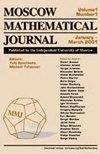Large Emission Regime in Mean Field Luminescence
IF 0.5
4区 数学
Q3 MATHEMATICS
引用次数: 1
Abstract
We study a class of random processes on $N$ particles which can be interpreted as stochastic model of luminescence. Each particle can stay in one of two states: Excited state or ground state. Any particle at ground state is excited with a constant rate (pumping). The number of excited particles decreases by means of photon emission through interactions of the particles. We analyse the rare event of flashes, i.e., the emission of a very large number of photons $B$ during a fixed time interval $T$. We employ the theory of large deviations to provide the asymptotics of the probability of such event when the total number of particles $N$ tends to infinity. This theory gives us also the optimal trajectory of scaled process corresponding to this event. The stationary regime of this process we call the large emission regime. In several cases we prove that in the large emission regime a share of excited particles in a system is stable under the changes of the pumping and emission rates.平均场发光中的大发射区
我们研究了$N$粒子上的一类随机过程,它可以解释为发光的随机模型。每个粒子都可以停留在两种状态中的一种:激发态或基态。任何处于基态的粒子都以恒定的速率被激发(泵浦)。激发粒子的数量通过粒子相互作用的光子发射而减少。我们分析了罕见的闪光事件,即在固定的时间间隔$T$内发射大量光子$B$。当粒子总数$N$趋于无穷大时,我们使用大偏差理论来提供这种事件的概率的渐近性。该理论还为我们提供了与该事件相对应的缩放过程的最优轨迹。这个过程的静止状态,我们称之为大排放状态。在几种情况下,我们证明了在大发射状态下,系统中受激粒子的份额在泵浦率和发射率的变化下是稳定的。
本文章由计算机程序翻译,如有差异,请以英文原文为准。
求助全文
约1分钟内获得全文
求助全文
来源期刊
CiteScore
1.40
自引率
0.00%
发文量
16
审稿时长
>12 weeks
期刊介绍:
The Moscow Mathematical Journal (MMJ) is an international quarterly published (paper and electronic) by the Independent University of Moscow and the department of mathematics of the Higher School of Economics, and distributed by the American Mathematical Society. MMJ presents highest quality research and research-expository papers in mathematics from all over the world. Its purpose is to bring together different branches of our science and to achieve the broadest possible outlook on mathematics, characteristic of the Moscow mathematical school in general and of the Independent University of Moscow in particular.
An important specific trait of the journal is that it especially encourages research-expository papers, which must contain new important results and include detailed introductions, placing the achievements in the context of other studies and explaining the motivation behind the research. The aim is to make the articles — at least the formulation of the main results and their significance — understandable to a wide mathematical audience rather than to a narrow class of specialists.

 求助内容:
求助内容: 应助结果提醒方式:
应助结果提醒方式:


